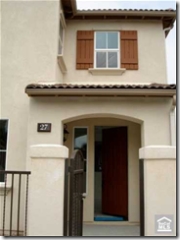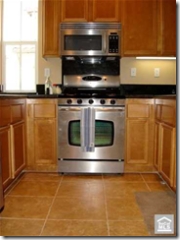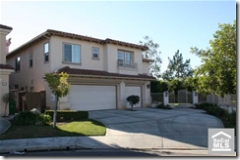This is the final installment in my series of related posts pertaining to the Irvine residential real estate market. It is my intention in this post to bring it all together, make a prediction as to the timing and depth of the upcoming crash, and describe the variables that will influence the market decline.
Below is a chart I created to demonstrate what I believe will occur in the Irvine Housing market between 2007 and 2013.
- Median sales price will decline approximately 40% from near $700,000 to near $400,000 over the next 5 years.
- There will be a multi-year flattening of prices at the bottom.
- Sustained appreciation will not return until 2013 or later.
- Peak bubble prices will not be seen until 2027 (unless we get another bubble).
Irvine Housing Market Prediction Spreadsheet
Due to the psychology of the market participants, I believe market prices will display the same general timing and pattern of the price decline of the early 90’s. The difference will be the depth of the decline which will likely be more than double on a percentage basis. It will take a 39% decline in Irvine to bring prices back in line with fundamental valuations. I am projecting house prices declining at an increasing rate over the next three years with 8% drops in 2007, 12% in 2008, and 16% in 2009. This will be a foreclosure driven decline.
Some will argue price drops of this magnitude are not likely, these would be unprecedented declines; however, if real panic selling grips the market, the rate of decline could be even greater. If you recall, the increases were unprecedented as well. The rate of decline should lessen as we approach fundamental valuations. I estimate declines of 8% in 2010 and 4% in 2011, followed by a period of 3 years with little change in prices. I am projecting a flattening of prices at the bottom because it will take time to absorb the inventory of foreclosures resulting from the drop.
I didn’t show it in the chart, but fundamental valuations do catch up to current prices eventually. If rents continue to increase at 3% per year (which is typical of wage inflation and consistent with its long-term average), current price levels will be justified in 2027 — twenty years from now. Does anyone think prices have reached what looks like a permanently high plateau.? Of course, given the propensity of the California housing market to bubble, once prices start to rise again in around 2013, they may reach current price levels by 2020.
I believe the decline depicted in the chart above will happen because of all the factors described in my previous posts:
I am IrvineRenter (Inventory Cholesterol)
Financially Conservative Home Financing
How Inflated are House Prices?
How Sub-Prime Lending Created the Housing Bubble
Timing and Depth of the Crash
What factors are in play that will influence the timing and depth of the crash? Throughout these posts, I have examined the psychological stages the market participants go through beginning with euphoria and the belief in continual appreciation and ending with depression and the belief that appreciation is dead. There are a number of technical factors which will influence the depth and timing of the decline:
- Percentage of Income Put Toward Housing Payments
- Interest Rates
- Forclosures
- Adjustable Rate Mortgage Time Bombs
- Government Intervention
One other factor of note is the relationship between median prices and actual prices which makes measuring the decline somewhat problematic.
Percentage of Income Put Toward Housing Payments
A change in buyer psychology which inevitably occurs during a market crash also influences people to put less of their income toward housing. Why would you stretch yourself to buy a depreciating asset? Historically, people have not. If people put smaller percentages of their income toward housing (both payments and rent), the fundamental value declines making for a lower bottom.
Notice on the chart that people put a smaller percentage of their income toward housing during price declines.
Interest Rates
Another key factor impacting the fundamental value and thereby the bottom is interest rates. As was pointed out in the comments on a previous post, interest rates went down during the last price decline which softened the impact. Mortgage Interest rates are near historic lows, and will likely increase. As lenders and investors in Mortgage Backed Securities (MBS) get burnt during the decline, they demand higher risk premiums. This increases the spread between the FED funds rate and mortgage interest rates, which is right now at a historic low. So even if the FED were to lower interest rates, the increased risk premiums demanded by lenders and MBS buyers will likely drive up mortgage interest rates. Higher interest rates mean lower prices and a lower bottom.
This is a potentially serious problem. The Federal Government must borrow enough money to service the budget deficit and the national debt. If the bursting of the housing bubble causes a worldwide credit crunch, interest rates will rise around the globe as cautious investors demand higher risk premiums. This may force the FED to raise interest rates to meet the obligations of the Federal Government. The combination of a higher FED rate and larger risk premiums could easily push interest rates back up to near the 8% historic norm or even much higher. An increase in interest rates from 6% to 8% is a 33% increase in borrowing costs. This would be disastrous for housing prices.
Notice mortgage interest rates are near historic lows and below historic averages. Is this sustainable?
Foreclosures
The wildcard in this analysis is the impact of foreclosures. The number of foreclosures will effect both the timing and the severity of the drop because it is foreclosures that drive prices lower. Based on the chart below, it is relatively safe to say that foreclosures are going to surpass levels seen in the early 90’s. At the rate of increase we see demonstrated below, we should surpass the 1996 peak this year.
Forclosures are increasing at an increasing rate and prices haven’t begun really dropping yet.
Foreclosures control the timing of the crash because they directly impact the must-sell inventory numbers. The greater the number of foreclosures, the greater the rate of decline in house prices. I have projected a dramatic decline in prices based on the trend in foreclosures we have seen to date. If the number and impact of foreclosures is worse than I thought, then the decline could happen even more quickly that I imagined. As I said in my first post, “Foreclosure statistics are the numbers to watch.”
I cannot overstate the importance of the foreclosures. Let’s be realistic, sellers will not lower their prices voluntarily. Prices will not drop without massive numbers of foreclosures to push them down. All of the “soft landing” arguments boil down to one supposition: the number of buyers in the market will be able to absorb the must-sell inventory on the market. If this is true, prices will not drop. If this is not true, prices will drop until enough buyers are found to purchase the foreclosures. There will be a number of buyers on the way down, some will be long-term homeowners who are present in any market, but many will be speculators betting on the return of appreciation. These people will be few in number, but there may be enough to them to buoy the market if there are not many foreclosures. If foreclosure numbers really spike, prices will fall until Rent Savers and Cashflow Investors enter the market and absorb the excess. IMO, the number of foreclosures will be too great for long-term owners and speculators to absorb.
Foreclosures also control the depth of the decline to some degree. Once prices fall down to their fundamental values, new buyers enter the market and begin to absorb the inventory. If there are not enough buyers at this price level to absorb all the foreclosures, prices could overshoot fundamentals to the downside; in fact, this does tend to happen at the bottom of the real estate cycle.
Adjustable Rate Mortgage Time Bombs
One of the most insidious problems of the housing bubble was the widespread use of adjustable rate mortgages. As I described in my post on conservative financing, adjustable rate mortgages are very risky; it is a risk that has been forgotten, ignored, or not understood by a great many buyers. Once prices have declined to a point where the loan balance is greater than the value of the property, mortgage holders will be unable to refinance when their mortgage reset comes due. Most often this will result in a foreclosure. In fact, this is going to be the primary mechanism of the decline, and it will also prevent any meaningful appreciation for years to come.
Imagine you are a homeowner, and your resale value has declined to where you could not cover your loan balance on a sale. You are able to make the payment on your ARM for another 3 years, but you will not be able to afford the reset. What would you do? I suspect you would list your house for sale at your breakeven value and hope the market comes back to save you. Hope is all you have. There are many, many people in this situation in the market. This is the nature of supply overhang.
These loans are time bombs waiting to go off. They have fuses of differing durations, but they will all explode eventually. These will not work their way out of the system for at least 5 to 7 years after they stop being used. They are still widely in use today. We are still sowing the seeds of the future supply overhang which will prevent home price appreciation.
Government Intervention
Because the problem with adjustable-rate mortgages is so large, this is an area where the government may intervene. There will be many borrowers who would be capable of making the payments on a conventional 30-year mortgage when their loan resets, but will be unable to refinance because they are underwater. For this group of borrowers, the government may institute a “loan guarantee” program similar to what they did for Chrysler in the 80’s. It would be in both the bank’s interest and the borrower’s interest to make the loan and have the borrower continue to make payments, and some banks will do this on their own (or be forced to in a “cram down“); however, many other banks will not, so a government program may become necessary to prevent further disruption in the market. This won’t do much for those with stated income (liar) loans, negative amortization loans, and others who are unable to make the payments (which is probably most buyers over the last 2-3 years). I don’t see the government getting involved in debt forgiveness or paying off the banks losses: It would be too expensive at a time when tax receipts will be down.
Another idea that has been floated is the potential for hyperinflation to bring wages and rents up to increase fundamental valuations. The FED will never allow this. One of the primary functions of the FED is to provide a stable financial system. Since stagflation of the 70’s, the FED has shown a willingness to push the economy into recession before it allows inflation to get out of control. In short, hyperinflation is not going to happen.
{adsense}
Related to hyperinflation is the devaluation of the dollar. Wages in the United States are already so high that jobs are being outsourced to foreign countries where people are paid much less. Wages cannot rise significantly from where they are without devaluing the dollar to prevent wage arbitrage from moving jobs overseas. In order for wages to rise in the United States (inflation) without causing jobs to move overseas, the dollar must decline in value. The FED doesn’t want to see this happen either. When a country knowingly devalues its currency, it causes a severe recession as the prices of imported goods and raw materials increases dramatically. Nobody wants a severe recession.
Median Prices vs. Property Specific Prices
The final phenomenon to note with respect to measuring the market decline is the difficulty in measuring the decline in values of specific properties. The median is not a particularly good measure of property values because it only measures how much was paid, not what you got for your money. If you sell your condo in today’s market for $500,000, wait a year, and buy a large detached home for $500,000, the median will not be impacted by those transactions, even though the sale and purchase represent a decline in housing prices. So it is possible this market crash could have individual properties decline 40% or more while the median is only off by 20%. It is probably more accurate to examine the sales prices on a per-square-foot basis to obtain a better measure the decline.
That being said, I think it is also likely that the median will decline 40% as well. The median is exaggerated because lenders are willing to loan people 10 times income to buy real estate. When credit tightens during the crash, lenders will pull back, eliminate the exotic loan terms, and keep their loans to the more conservative 3 to 4 times earnings. If this occurs, the median will decline as people’s borrowing power is reduced.
Summary
If prices follow their historical pattern, they will fall down to their fundamental valuations over the next 5 years. This drop will represent a 40% decline in prices during that time. There are a number of variables which will influence the depth and timing of the decline which I have described in this post. Most of the risks are to the downside. IMO, there will be overshoot. What I believe we will see is a decline in the median to the levels as described, but the price declines in individual properties will be greater. By 2012 the starter homes currently going for $600,000 may be selling for $300,000. As I am sure someone is going to point out, this is all supposition and speculation; it is. Despite all the nuance and fancy analysis, everything comes down to one simple indicator: to paraphrase James Carville and Bill Clinton, “It’s the Foreclosures, Stupid!”
.
This post is my last in this series laying out the case for a market decline. I want to take this opportunity to thank all of you who read these posts and shared in the discussion. Your words of support and thanks I saw throughout the comments are much appreciated.
.
If any of you would like to make a prediction, here is a Crystal Ball for you.
.
Update: from Housing Panic












